What Is a Floodlight? Types & Best Uses Explained
-
Jeff Weishaupt
- Last updated:
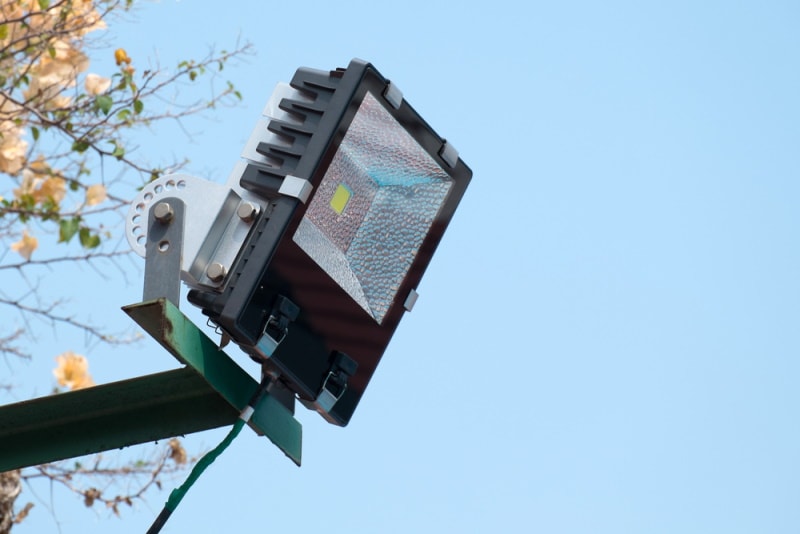
Floodlights are high-intensity artificial lights with a broad beam. They are designed to lighten up larger areas, such as sports grounds, parking lots, backyards, concerts, etc. The word “flood” doesn’t have to do anything with flood or water. Instead, the entire term means that the light is “flooding” an area from various angles.
Floodlights serve multiple purposes. For instance, they not only provide better visibility but also support television broadcasts during professional sports. Furthermore, floodlights are also popular among homeowners for security reasons.
Previously, metal halide and sodium were widely used in flood lights as lighting sources. However, nowadays, LEDs have replaced them. In fact, most floodlights available in the market consist of LEDs.
But how do floodlights work, and what are their advantages and disadvantages? Keep reading to find answers to all your questions related to floodlights. We will also tell you where to install a floodlight to enhance your home security. Let’s get started!
How Does It Work?
Floodlights are particularly designed to brighten up large outdoor areas. They work by flooding the entire area with light from multiple angles. These artificial lights produce intense, broad light beams, spreading up to 120 degrees.
Floodlights lighten up a larger area than the spotlight while maintaining the same lumen output (wattage). That’s the main reason homeowners prefer floodlights over spotlights. Not only sports grounds, but floodlights also work amazingly in back and front yards, patios, and driveways. This helps you keep an eye on things happening close to your property.
Floodlights require batteries, electricity, or solar power to work. Depending on the types of lights used in floodlights, there are six major categories: LED, halogen, sodium vapor, HID, incandescent, and fluorescent. We will discuss these in detail later on.
It’s important to know how to choose the right type of floodlight to make it work for you. Three types of LED floodlights work differently for different purposes. Here is a brief discussion of them:
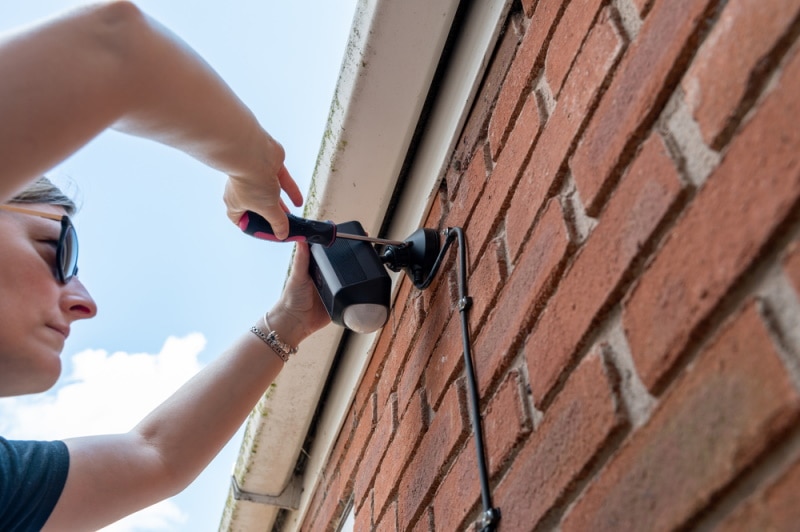
- Twin-Head Floodlights. This is the most common option for residential uses. Like their name, the twin-head floodlights have two heads, each facing away from the other to provide maximum coverage.
- Multi-Head Floodlights. These floodlights have more than two heads to offer greater light coverage than the two-head floodlights. This makes them ideal for larger areas.
- Single-Head Floodlights. These are less common floodlights that cover smaller indoor and outdoor spaces.
What Are the Different Types of Floodlights?
Choosing the right type of floodlight plays a major role in making them work for you. So, whether you opt for a single-head or multi-head floodlight, you should also know what types of light or bulbs it contains.
Here are the six most common types of floodlights based on the light sources:
1. LED
LED floodlights are powered by LED technology which is popular for energy efficiency. They are the most common floodlights installed outside residential and commercial buildings. LED floodlights come in various shapes and sizes, serving different purposes.
You may find different options in LED floodlights. These floodlights are categorized into four types: R, BR, MR, and PAR. Every letter represents the specific bulb style. For instance, R means reflector, BR indicates bulged reflector, MR denotes multifaceted reflector, and PAR represents parabolic aluminized reflector.

2. Sodium Vapor
Sodium vapor makes sodium lights glow by interacting with electric current. It is used in low-pressure floodlights consisting of sodium lights. A few years back, sodium vapor was the most common type of light source because it was the most energy-efficient option. Not only that, but it also offered the lowest maintenance costs.
However, sodium lights produce yellowish light beams, which many people do not love. The lights also take longer to brighten up after turning on the fixture.
If you want a floodlight for your home security, this won’t be your ideal option. That’s because these floodlights are ineffective for security reasons since they don’t have alarm signals.
3. Halogen
Some floodlights consist of quartz halogen bulbs with halogen gas and tungsten. When powered on, the electricity activates the components of the bulbs and brightens up the light. Many people love the white light of halogen gas. However, halogen lights heat up more often and are less efficient than other floodlights.

4. High-Intensity Discharge (HID)
These floodlights come with a high-intensity ballast inside the bulb. When interacting with the electric current, the light brightens and radiates from the bulb. Also, high-intensity discharge floodlights are the most durable and highest-efficiency lights. In fact, Energy Savers rates these lights as 75-90% more efficient than incandescent floodlights.
But unfortunately, high-intensity discharge lights take longer to lighten up like sodium lights. This is the main reason these floodlights don’t come with motion detectors. But even if they do, the feature doesn’t work properly.
5. Incandescent
Incandescent is an element of the bulb present in a vacuum. It heats up after coming in contact with an electric current. While many users love incandescent floodlights for their lower costs, they have a shorter lifespan.
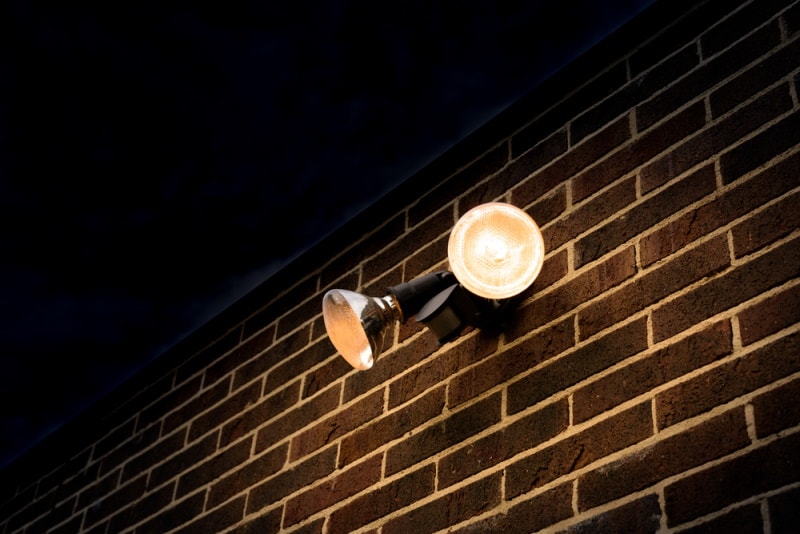
6. Fluorescent
Last but not least, fluorescent floodlights consist of a phosphorescent coating on the inner side of the bulb and mercury gas. When electricity interacts with these materials, the light brightens up. Fluorescent floodlights have a longer lifespan than incandescent bulbs but are more expensive.
 Where Is It Used?
Where Is It Used?
Floodlights can be used in any large area That you want to lighten up. While most floodlights are used in walkways, backyards, or play areas, some are ideal for smaller indoor and outdoor places. Let’s have a look at some of the most common areas where floodlights are used:
- Ports require a significant amount of light since they are open the entire day or week. Also, these areas are quite large, requiring continuous light from different angles 24/7. Therefore, installing floodlights in these areas is the ideal way to keep them brightened.
- Industrial buildings also remain open 24/7, demanding a continuous and intense light supply. And what could be a better choice than floodlights?
- Architectural buildings and monuments need to be visible the entire day. Installing floodlights in these areas can help attract visitors and deter criminals or intruders. Architects recommend different lighting techniques to highlight the important aspects of the building.
- Facade Lighting. Floodlights can brighten up a particular part of the building to divert the viewer’s attention toward it. These lights especially come in handy when highlighting the company’s sign or logo on the building’s front.
- Sporting Events. Floodlights are mostly used in outdoor sports events in the evening or in low-light conditions. These lights ensure that the area has sufficient artificial light for clear visibility. Apart from the visibility, floodlights also support television broadcasts and ensure they deliver the finest quality.
- Theaters and Concerts. Floodlights are ideal for concerts and theatrical areas. They lighten larger areas, but their beam can also focus on a specific point. This makes them the number-one choice for various events.
- Home Security. Floodlights are also used for security purposes in homes and offices. They come with motion sensors that trigger the light to brighten up whenever a burglar comes close to the property. Floodlights also remain powered on all the time to tell the trespassers that they’re being seen.
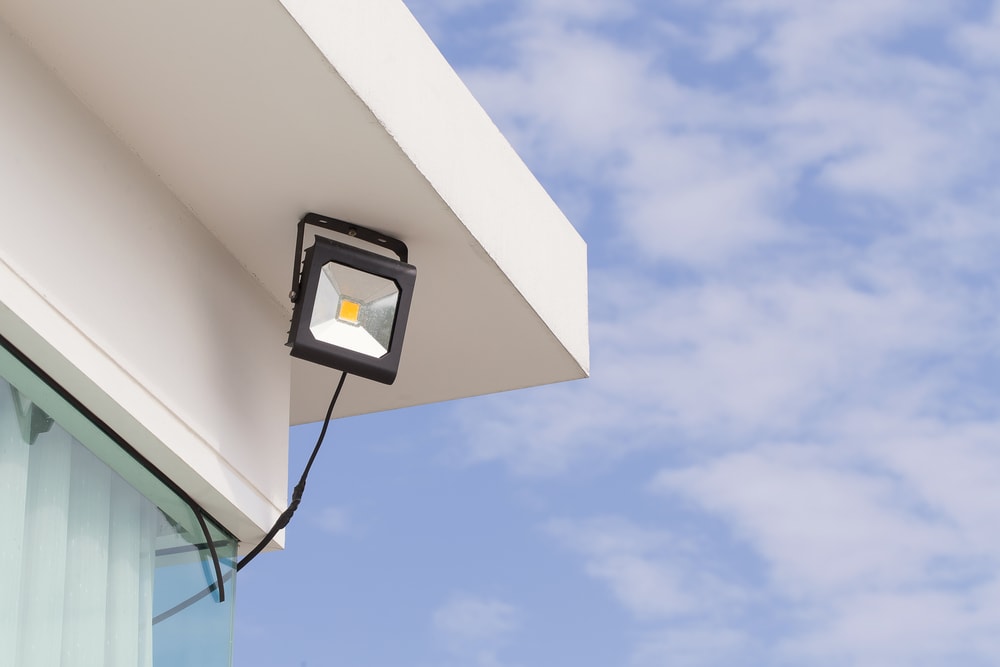
Advantages of Floodlights
Floodlights are undoubtedly the best lighting fixtures for large areas. Here are some other advantages of floodlights besides their wide coverage capacity:
Long Life
The longevity of a floodlight varies depending on its type. LED floodlights are generally considered longer lasting than other types of lights. These lights can last up to 50,000 hours, which is pretty impressive compared to halogen lights.
Floodlights with a long life don’t require frequent replacement or maintenance. This makes them an economical option to lighten up and observe different areas.
Energy Efficient
LED floodlights are considered energy-efficient because they produce intense light beams without using much power. As a result, these lights can brighten considerable species with minimum electricity consumption.
High Lumen Output
Lumen output determines how bright a light is. The higher the lumen output, the brighter the light source will be. LED flashlights have a high-lumen output, which is why they are the most popular.
Improved Thermal Output
Commercial lights often produce significant heat that you can easily feel by touching them. Comparatively, LED lights remain cooler even after working for hours.
Their thermal management system generates less heat, making them ideal for places where high heat can be a problem. These include manufacturing plants and ports.
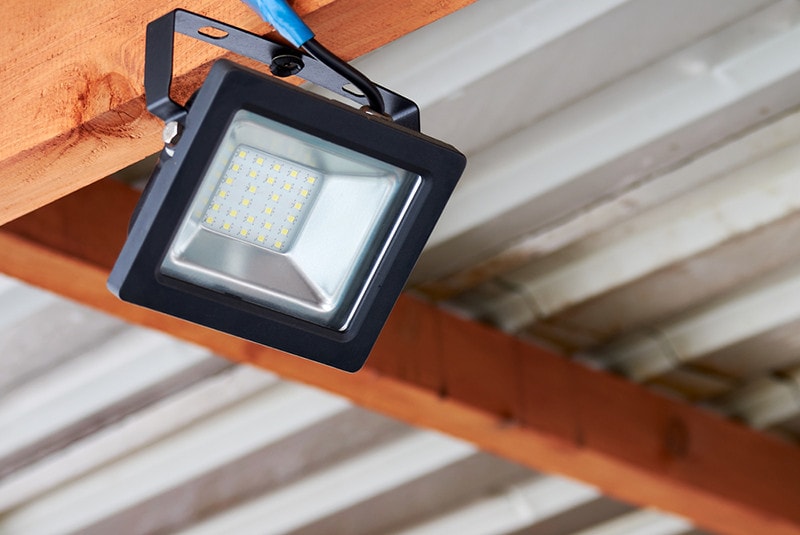
Eco-Friendly
Sustainability and climate change are one of the two most common global concerns at the moment. This makes LED floodlights a popular choice for people looking for eco-friendly products. LED lights don’t contain harmful elements, such as lead, glass, or mercury, which is why they are entirely safe for the environment.
Durability
Another advantage of LED floodlights is their durability. They know how to withstand the toughest weather conditions like a pro. The high-quality floodlights are IP65 rated, meaning they are weatherproof whether it rains or snows outside.
The high durability of floodlights makes them the perfect lighting fixtures for ports, manufacturing facilities, and residential buildings alike. No wonder why these lights are considered longer lasting than traditional lights.
Cost Efficient
LED lights are usually more expensive than traditional bulbs, but it is just the initial cost. When you see things in the long run, you’ll find that LED floodlights require fewer maintenance costs and replacements. This makes them cost-efficient, with a significant payback within 1 to 2 years.
Moreover, the lights in floodlights are brighter. They also require less electricity since brighter lights mean fewer bulbs would be lightning up.
Disadvantages of Floodlights
With floodlights, you may encounter some disadvantages as well. However, they are less than the advantages, so ignoring them is easy. Here are two downsides of using a floodlight:

Higher Initial Costs
Floodlights are one of those investments that show their benefits in the long term. Unfortunately, while that’s a good thing, many people can’t afford the higher initial costs of LED floodlights. In fact, LED lights are considered three to five times more expensive than traditional bulbs.
Nevertheless, floodlights lead to a significant reduction in electricity bills, bulb replacements, and maintenance. So, always look in the long run when buying a floodlight.
Limited Features
Some models may not offer the features that make floodlights this brilliant. For example, many floodlights don’t come with the most important feature, motion detection. So, if you want a floodlight for security reasons, such models won’t benefit you at all. However, they are still ideal for lighting purposes.
Frequently Asked Questions (FAQs)
Here are some frequently asked questions related to floodlights:
What Is a Floodlight Used for?
Floodlights are used specifically for big outdoor areas. They produce wider light beams, flooding a considerable area with intense light. Floodlights are ideal for brightening up larger spaces with a wattage or lumen output similar to a spotlight.
Why Are They Called Floodlights?
They are called floodlights because they actually flood an area with high-intensity lights. This means the word “flood” is not associated with “flood” or any other water source.
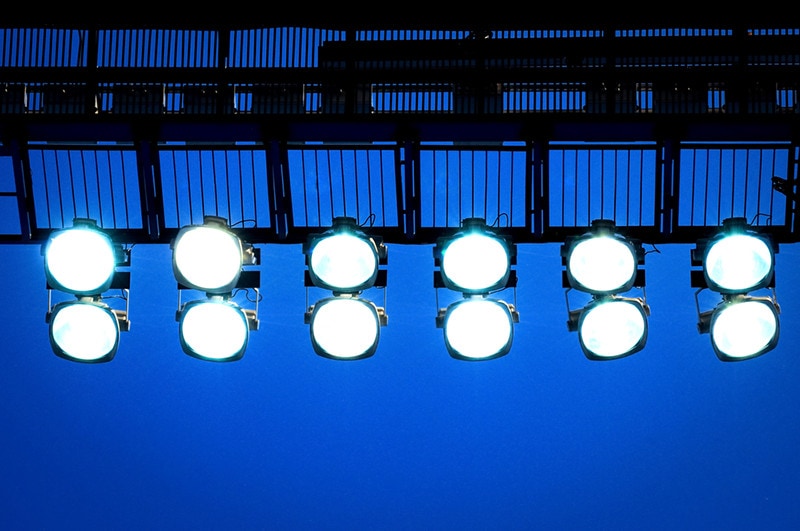
When Should I Use a Floodlight?
You should use a floodlight to illuminate larger areas like parking lots, warehouses, driveways, or any place that needs sufficient light coverage.
What Is the Difference Between Floodlight and Spotlight?
Spotlights have a narrow beam of light, not more than 45 degrees. So, they are the best options for highlighting specific parts of a particular area, such as a logo on a company’s building. On the other hand, floodlights have a wider beam angle, ranging between 90–120 degrees. Thus, they can illuminate larger areas, including parking lots, backyards, front porches, etc.
Where Do You Place Floodlights?
The ideal placement for floodlights is in the area where you need light the most. This could be your garage, backyard, front door, driveway, walkway, etc. Floodlights don’t only brighten up an area, but they also protect an area against burglars.
Conclusion
Floodlights are an important part of your home or office security. They not only brighten up large areas but also detect motion to keep burglars and intruders away. While most lights lighten up after sensing motion, some remain powered 24/7.
When choosing a floodlight, make sure you know all the types available in the market. This way, you will easily pick the light you need without feeling overwhelmed. LED floodlights are the most common, functional, and energy-efficient of the six types of floodlights.
Don’t get turned off by the high initial costs of floodlights. Instead, consider them an investment that will surely benefit you in the long run!
- https://www.homedepot.com/c/ab/security-flood-lights-for-your-home/9ba683603be9fa5395fab9058e7ffaa#:~:text=Flood%20light%20bulbs%20are%20specifically,lumen%20output%20as%20a%20spotlight
- https://www.lepro.com/learning/what-is-floodlight/
- https://www.backyardboss.net/what-is-a-flood-light-and-how-it-works/
- https://www.lampshoponline.com/advice/your-complete-guide-to-floodlights
Featured Image Credit: Phakorn Kasikij, Shutterstock
Contents
